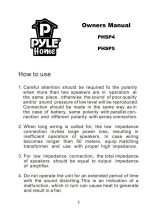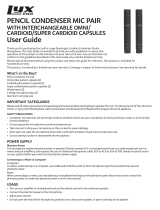
ongratulations on the purchase of Blue’s Kiwi
microphone. The transformerless Kiwi is the top of
our solid-state microphone line, combining the low
noise and superb transient response of top-grade
modern electronics with the crisp, airy high end of
legendary vintage vocal mics.
At the heart of the Kiwi is a multi-pattern variation
of Blue’s B6 Bottle microphone capsule. To provide
a consistent response throughout the range of
pickup patterns, two single backplate, large
diaphragm capsules are acoustically matched,
then measured in our anechoic chamber for opti-
mum performance. The end result is a handcrafted
and hand-tuned dual backplate capsule, delivering
a modern tone with a smooth extended top-end.
Though designed primarily to achieve a world-
class contemporary vocal sound, this capsule can
be utilized to add a glossy, produced sheen to sax-
ophone, piano, electric guitar, and other lead
instruments. In omnidirectional and figure of eight
patterns, or when miking at a distance, the Kiwi
delivers every nuance in the room, with finely
focused resolution and clear, musical frequency
response — ideal for distant acoustic guitar
recording, ambient percussion miking, and uncon-
ventional vocal treatments. In its cardioid patterns
the Kiwi excels at delivering a vocal or solo track
right to the front of the mix where it belongs, with
detailed highs, smooth midrange, and minimized
proximity effect (a bass boost inherent in all unidi-
rectional mics).
Getting Started
The Kiwi system includes Blue’s custom
The Shock
suspension shockmount, along with a velvet-lined
cherrywood box which houses the microphone.
The Shock
is designed to isolate the Kiwi microphone
body from low frequency vibrations when mounted
on a stand. To fit the Kiwi into this assembly, first
open the wire latches on the upper and lower
circular padded bands situated inside the shock
mount frame. Then simply slide the Kiwi into the
bands, make sure that the pattern selector switch
is accessible, and close the wire latches to tighten
the bands around the microphone. The angle of the
mount assembly can be swiveled and adjusted
with the large thumbscrew, which will normally be
positioned at the rear of the mic.
C
Once you have the Kiwi secured in its shockmount, you may find it easiest to attach the assembly to
a stand by 1) loosening the boom stand arm or threaded end of the mic stand, 2) grasping the mount
assembly in one hand, and 3) screwing the mic stand threads into the mount, without over-tightening.
This procedure will eliminate any possibility of damage to the mic.
NOTE: Forceful positioning of
The Shock without loosening of the thumbscrew can result in damage not covered by warranty.
To get the most out of this, or any quality
microphone, it is essential to pair it with
a good microphone preamplifier. Most pro-
fessional recordists prefer to have out-
board preamps on hand, and will choose
solid-state or vacuum tube models
based on their unique characteristics. To
maintain the integrity of your signal, try
using Blue’s Cranberry, Blueberry or
Kiwi high-definition mic cable along with Blue’s outstanding Class-A vacuum tube mic preamp,
Robbie. And, whenever possible, connect your pre’s output directly to your recorder or A/D convert-
er, bypassing the mixing board and any unnecessary components.
The Kiwi requires +48V phantom power, which is provided by most mic preamps, mixing consoles,
or separate phantom power supplies. It is important to note that some units, though rated at 48
volts, may supply insufficient or unstable phantom power, which can result in distortion and/or
degraded performance when used with the Kiwi.
To avoid damage to audio components when connecting phantom power, follow this simple procedure:
1) turn down the mic preamp gain, headphones, and your studio monitors, 2) connect microphone
cable to the Kiwi and microphone input jack, 3) turn on phantom power, 4) turn up the mic preamp
gain, etc. To disconnect or re-route the Kiwi, 1) turn down the mic preamp gain, headphones, and
your studio monitors, 2) turn off phantom power and wait 10 seconds before disconnecting the mic.
To secure the delicate capsule during transport and shipping, three brass
set screws are provided. These screws should be mounted in the solid
metal ring around the circumference of the grille when you first take the
microphone out of its case. Remove these screws before using the
microphone, and replace them if you will be transporting or shipping the
microphone.
NOTE: The Kiwi will not work properly if the security screws
are not removed.
Capsule and Pattern Characteristics
When recording in a unidirectional pattern, the active, on-
axis diaphragm is on the same side of the microphone as
the Blue logo. The pattern selector switch is located at the
rear of the microphone, and is easily adjusted by hand, with
no special tools required. In addition to the standard cardioid,
omnidirectional, and figure of eight patterns marked on the selector
switch, there are 6 intermediate gradations of sub-cardioid (between
omni and cardioid) and super-cardioid (between cardioid and figure of
eight) patterns to choose from.
You will notice that the sound of the Kiwi capsule changes when
adjustments are made to the nine-position pickup pattern switch on the
microphone body. In general, the omnidirectional pattern offers the
flattest frequency response, with an absence of proximity effect. As the
pattern becomes more directional (by clicking clockwise through the
L-R:
The Pop; Blueberry, Cranberry,
&
Kiwi
cables;
Robbie the Mic Pre
Kiwi shown with
The Shock








